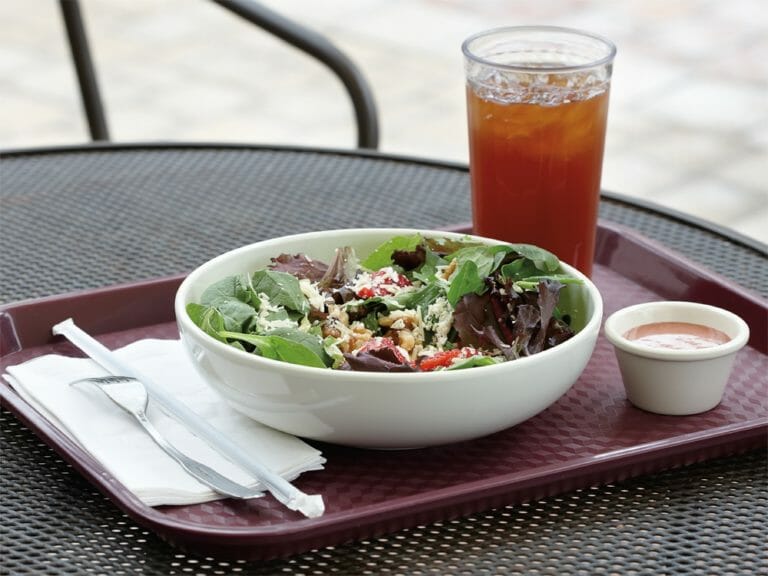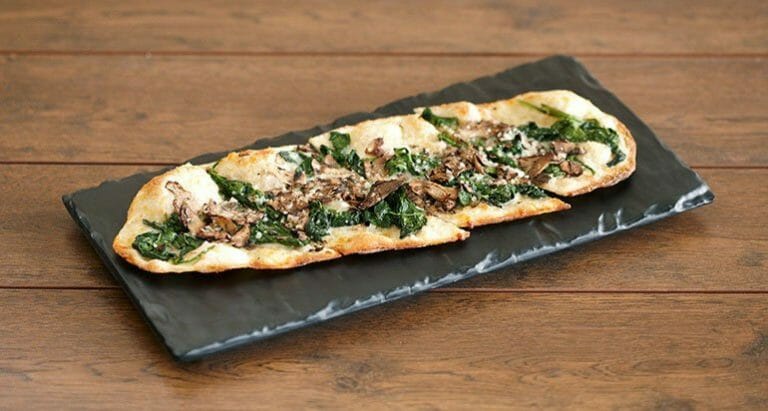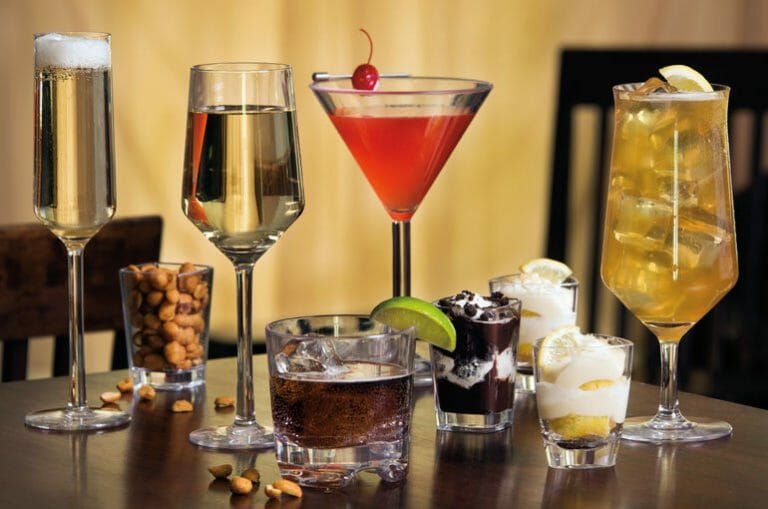Stainless Steel & Aluminum Uses in Foodservice Operations
Imagine a commercial kitchen with no stainless steel or aluminum. It’s hard to do, isn’t it? That’s because stainless steel and aluminum are the most commonly used metals in foodservice. Stainless is a bit more popular than aluminum, but they’re both used in countless front-of-the-house applications.
But what’s the difference between the two metals? Why would you use one over the other, or does it even matter? We’re going to walk you through the qualities of each metal and showcase some of G.E.T.’s front-of-the-house examples where each metal shines on its own.
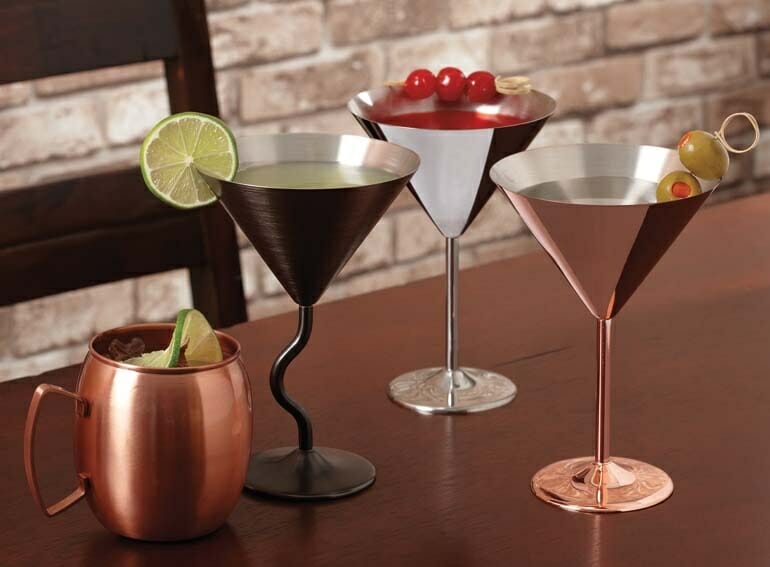 Pictured: Stainless Steel Copper-Plated Mug, Stainless Steel Martini, Stainless Steel Copper-Plated Martini,
Pictured: Stainless Steel Copper-Plated Mug, Stainless Steel Martini, Stainless Steel Copper-Plated Martini,
Stainless Steel in Foodservice Operations
The most popular foodservice metal, stainless steel takes up residence in tabletop applications due to its durability, cleanability, and often elegant look. Of the many grades of stainless available on the market, the ones primarily used in foodservice are 18/8 and 18/0.
Grade 18/8 and 18/0 Stainless Steel Similarities
Grade 18/8 stainless steel is favored over grade 18/0 because it’s a bit sturdier, but they each get plenty of love from foodservice operators. For both, the top number represents the percentage of chromium present in the metal. The bottom number does the same for the percentage of nickel.
Chromium reduces the opportunity for rust to form because it creates a barrier on the surface, essentially locking out oxygen. This property makes stainless steel highly anticorrosive, while nickel supports the overall durability and shine. Grade 18/0 doesn’t have any nickel, which is why 18/8 is sturdier and more lustrous.
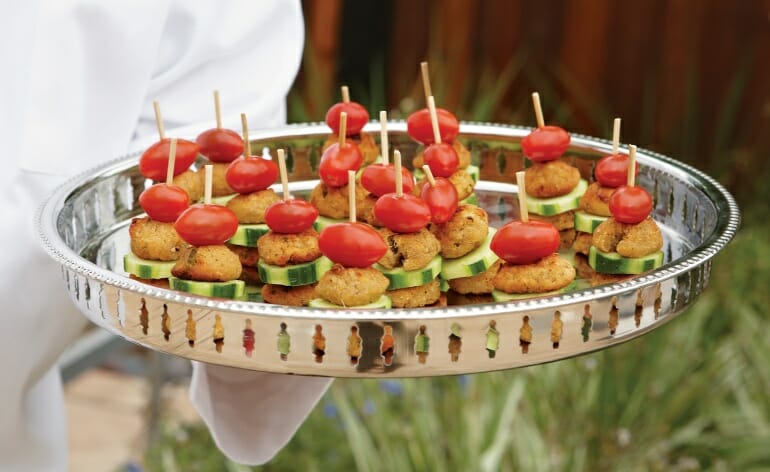 Pictured: Stainless Steel Round Tray
Pictured: Stainless Steel Round Tray
The anti-corrosive properties of stainless steel are central to its popularity. It doesn’t react with naturally occurring acids or bases (alkalies) in food, and it’s dishwasher-safe, which makes it a fine candidate for tableware.
Both 18/8 and 18/0 are durable and can withstand high-volume tabletop rotation. Stainless steel can dent or scratch, but less easily than aluminum due its higher density. Over time, you’ll need to replace these pieces, but universally, stainless steel generally has the best service life of all the food-safe metals, including aluminum. However, service life is of course dependent on the thickness of the metals because the metals alone are made and used in different weights and designs for various features and benefits.
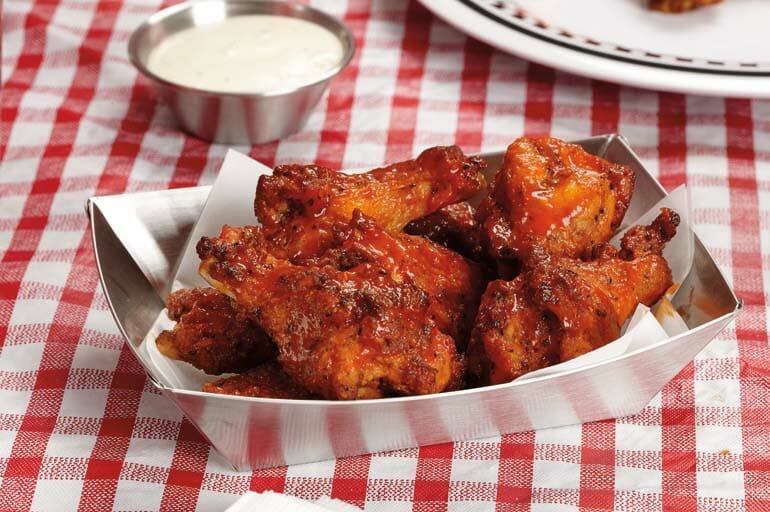 Pictured: Stainless Steel Boat Tray, 2 oz. Condiment Cup
Pictured: Stainless Steel Boat Tray, 2 oz. Condiment Cup
Easily sanitized ware is one way to a foodservice operator’s heart. Because stainless steel is non-porous and frequently manufactured with a smooth surface, there’s no place for food to hide. Food stays on the exterior, so once it’s cleaned, you don’t have to worry about small, hard to see pieces of food sticking around.
Engraving or embossing can be performed on both grades of stainless steel. If your operation typically incorporates custom branding into their tabletop pieces, stainless will be able to accommodate this practice.
{{cta(‘b328eb8c-da26-4c29-b25d-21311cb4c664’)}}
Grade 18/8 and 18/0 Stainless Steel Differences
The biggest difference is that 18/0 does not contain any nickel. Like we mentioned earlier, the absence of nickel means a few things:
- Softer shine
- Less durable than 18/8
- May stain or corrode faster than 18/8, requiring it to be replaced more often
- Magnetic
Without nickel, 18/0 is more susceptible to staining and corrosion, but it’s still a very popular food-safe metal.
 Pictured: Stainless Steel Serving Utensils, Stainless Steel Action Stations
Pictured: Stainless Steel Serving Utensils, Stainless Steel Action Stations
If your operation includes induction cooking, sometimes used for action stations/display cooking, 18/0 stainless is naturally induction-ready. Grade 18/8 isn’t always suitable for induction, so if you want to use that method of cooking, stick with 18/0 and you’ll be fine.
At G.E.T., we use 18/8 for its superior shine, durability, and anticorrosive properties (except for products intended to be used for induction cooking) because we know how much foodservice operators value these qualities.
Aluminum in Foodservice Operations
Aluminum is the second-most used metal in foodservice. Like stainless steel, it can be used for a wide variety of applications, which helps its popularity and usefulness regarding tabletop service. Aluminum has zero carbon in it, which means it’s incapable of rusting. You can expect to find similar types of ware made from aluminum that you can with stainless, but their service life, characteristics, and costs are different.
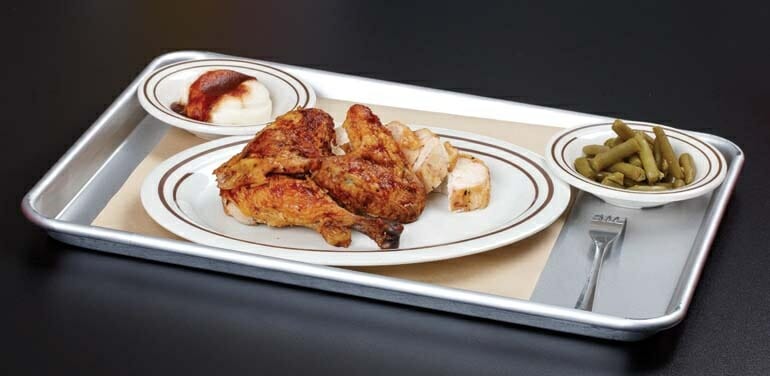
Pictured: Aluminum Rectangular Tray, 12″x12″ Waxed Food-Safe Paper, Ultrawareª Oval Platter, Ultrawareª 3.5 oz. Bowls
Aluminum’s durability is substantial enough to be commonly used in dinnerware and display pieces, but it’s not as strong as stainless steel, which means that it can dent and scratch more easily. If aluminum gets dented, you don’t necessarily have to stop using it right away, but overall, aluminum’s service life is a good deal shorter than stainless’ if it’s used in similar application pieces.
Naturally occurring acids and bases in foods will wear down aluminum over time, which does not happen with the types of stainless steel discussed above. Foodservice operators will want to look for aluminum pieces with coating that supports a longer service life if opting for aluminum in place of a similar item made with stainless steel. Aluminum’s reactivity won’t affect foods’ taste, appearance, or smell; it simply affects the overall life of aluminum pieces.
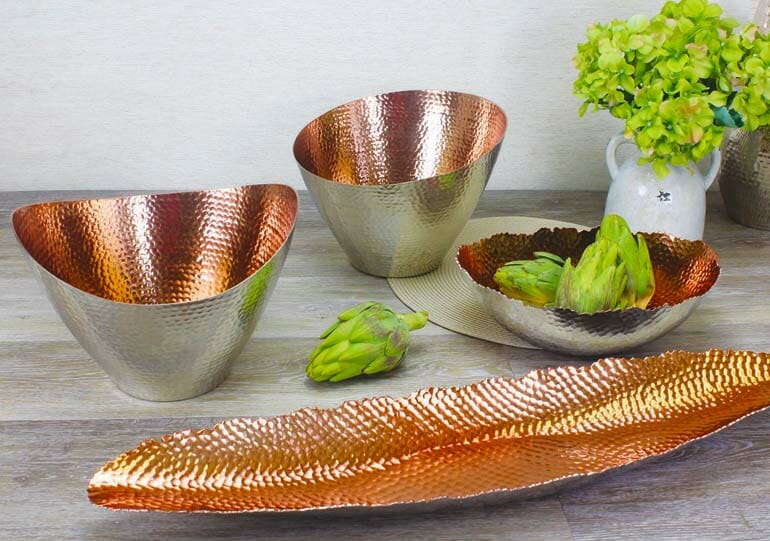 Pictured: Pampa Bay Hammered Copper Aluminum Displayware – Coming Soon!
Pictured: Pampa Bay Hammered Copper Aluminum Displayware – Coming Soon!
Some of the displayware by Pampa Bay, which will soon be available through G.E.T., is undeniably gorgeous. The pieces made from aluminum (some of Pampa Bay’s collection is made from titanium porcelain) are designed for elegance, but are lightweight and very competitively priced. A portion of Pampa Bay’s collection, like the one pictured below, are made from aluminum sheets, which have a stronger durability blend and food-safe applications. These are amazing options that can elevate your hospitality display while sticking to your budget.
Due to aluminum’s reactivity to acids and bases in foods, you’ll want to ensure proper care and maintenance procedures are carefully followed. This is because some pieces, like the Hammered Copper above, require care soon after service via hand-washing with a gentle cloth and being allowed to completely dry. Doing so will help you get the best service life out of your displayware.
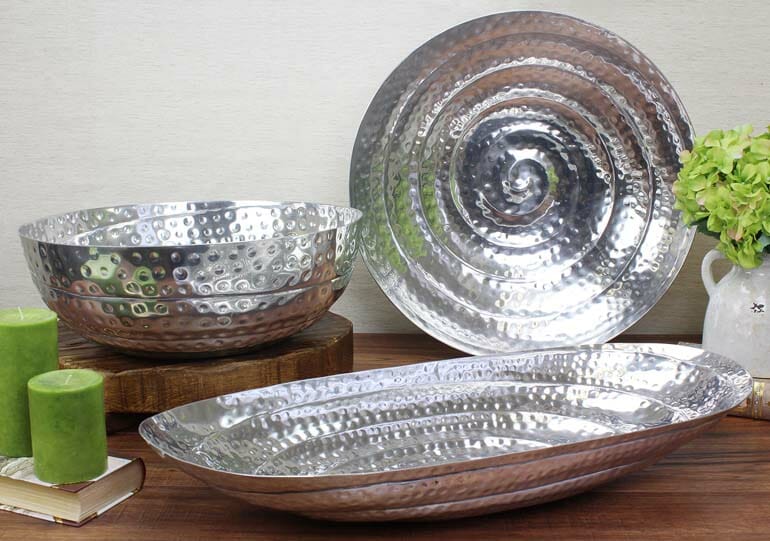 Pictured: Pampa Bay Aluminum Displayware – Coming Soon!
Pictured: Pampa Bay Aluminum Displayware – Coming Soon!
An excellent conductor of temperature, aluminum can reach desired degrees faster and hold them longer than most of the commonly used food-safe metals. You can freeze or refrigerate aluminum vessels for ice cream or other dessert service, or keep salad bowls cool, which helps keep your product crisp before it’s tossed and served.
Enamel-Coated and Resin-Coated Aluminum
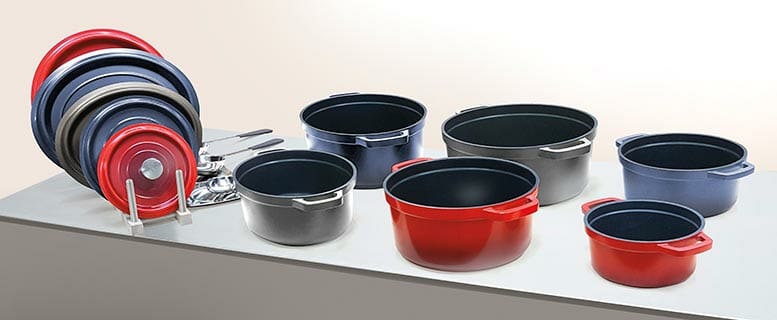 Pictured: Heissª Induction Cookware
Pictured: Heissª Induction Cookware
Enamel-coated aluminum is now available on the market because it can mimic the look of enamel-coated cast iron pieces, made popular by Le Crueset. Available in an array of colors with a dark black enamel coating on the inside, these striking pieces are less expensive, lighter weight, and chip less often that traditional cast iron. Heissª, G.E.T.’s line of enamel-coated aluminum, is developed with an induction-ready base, so it can be used on an induction range for action station service at buffets or catering events. We recommend reading “Enamel Cast Iron vs Cast Aluminum Induction Cookware for Foodservice” if you’d like to learn more.
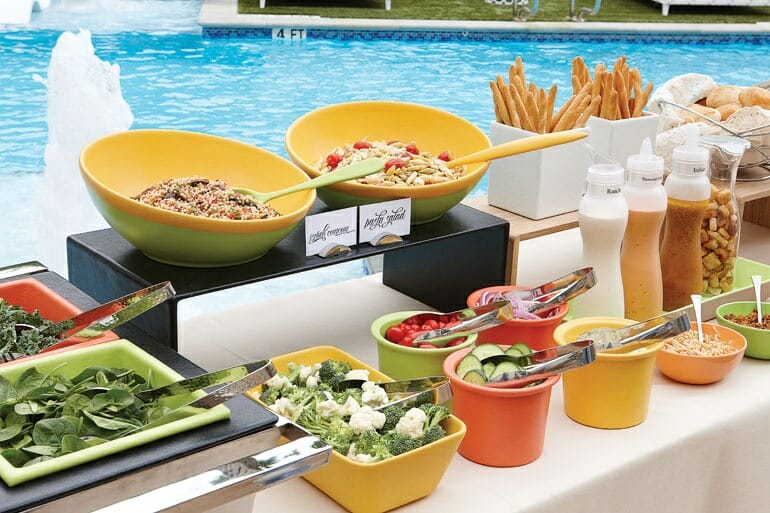 Pictured: Bugambilia® Classic Inserts, Food Pans, & Salad Bowls
Pictured: Bugambilia® Classic Inserts, Food Pans, & Salad Bowls
Resin-coated aluminum, like G.E.T.’s Bugambilia® line are also popular aluminum choices. The resin coating gives them an attractive, inviting look, perfect for buffet salad bars and other displayware. Because aluminum is such a great conductor of temperature, this serveware is perfect for holding cold food, keeping food fresh and crisp longer than it would be otherwise. Operators enjoy the dishwasher-safe aspect, as well. Bugambilia® is also now available in a new smooth coating, giving you more options for designing your salad bar and displays.
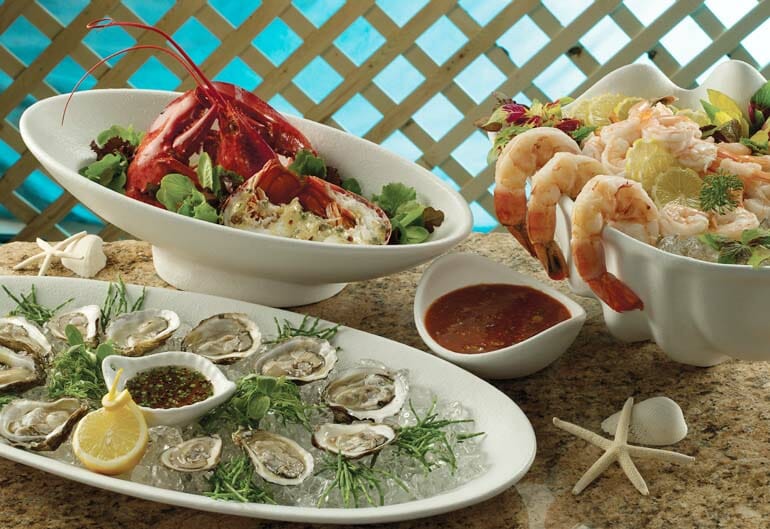 Pictured: Bugambilia® Classic Serveware
Pictured: Bugambilia® Classic Serveware
It’s likely every foodservice environment you’ll ever be in will embrace these two materials, so it’s good to get a sense for their qualities and why they’re used where they are. If you’d like to dig deeper into the differences between the two stainless steel grades discussed here, we recommend reading Grades of Stainless Steel & What They Mean for Your Foodservice Operation.


